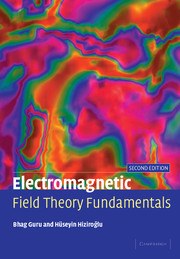Book contents
- Frontmatter
- Contents
- Preface
- Acknowledgments
- 1 Electromagnetic field theory
- 2 Vector analysis
- 3 Electrostatics
- 4 Steady electric currents
- 5 Magnetostatics
- 6 Applications of static fields
- 7 Time-varying electromagnetic fields
- 8 Plane wave propagation
- 9 Transmission lines
- 10 Waveguides and cavity resonators
- 11 Antennas
- 12 Computer-aided analysis of electromagnetic fields
- Appendix A Smith chart and its applications
- Appendix B Computer programs for various problems
- Appendix C Useful mathematical tables
- Index
8 - Plane wave propagation
Published online by Cambridge University Press: 05 June 2012
- Frontmatter
- Contents
- Preface
- Acknowledgments
- 1 Electromagnetic field theory
- 2 Vector analysis
- 3 Electrostatics
- 4 Steady electric currents
- 5 Magnetostatics
- 6 Applications of static fields
- 7 Time-varying electromagnetic fields
- 8 Plane wave propagation
- 9 Transmission lines
- 10 Waveguides and cavity resonators
- 11 Antennas
- 12 Computer-aided analysis of electromagnetic fields
- Appendix A Smith chart and its applications
- Appendix B Computer programs for various problems
- Appendix C Useful mathematical tables
- Index
Summary
Introduction
We have stated a⃗ this in Chapter 7 and we state it again: Maxwell's equations contain all the information necessary to characterize the electromagnetic fields at any point in a medium. For the electromagnetic (EM) fields to exist they must satisfy the four Maxwell equations at the source where they are generated, at any point in a medium through which they propagate, and at the load where they are received or absorbed.
In this chapter, we concentrate mainly on the propagation of EM fields in a source-free medium. As the fields must satisfy the four coupled Maxwell equations involving four unknown variables, we first obtain an equation in terms of one unknown variable. Similar equations can then be obtained for the other variables. We refer to these equations as the general wave equations. We will show in Chapter 11 that the fields generated by time-varying sources propagate as spherical waves. However, in a small region far away from the radiating source, the spherical wave may be approximated as a plane wave, that is, one in which all the field quantities are in a plane normal to the direction of its propagation (the transverse plane). Consequently, a plane wave does not have any field component in its direction of propagation (the longitudinal direction).
We first seek the solution of a plane wave in an unbounded dielectric medium and show that the wave travels with the speed of light in free space.
- Type
- Chapter
- Information
- Electromagnetic Field Theory Fundamentals , pp. 351 - 420Publisher: Cambridge University PressPrint publication year: 2004

